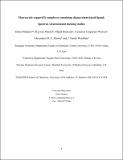Macrocyclic copper(II) complexes containing diazacyclam-based ligand : spectral, structural and docking studies
Abstract
The macrocyclic copper complex, [Cu(ACE)(NO3)2] (ACE = 1,3,6,10,12,15-hexaazatricyclo[13.3.1.16,10]eicosane), was synthesized by template condensation from a mixture of N1-(2-aminoethyl)-1,3-diaminopropane, formaldehyde and copper(II) nitrate. Replacement of the nitrate with thiocyanato and azido ligands gives [Cu(ACE)NSC]NSC ( 2 ) and the 1D-coordination polymer, [Cu(ACE)(μ-N3)]n[N3]n ( 3 ), respectively. Complex 1 , [Cu(ACE)(NO3)]NO3, is an intermediate product in which one of the nitrate ions is separated from its parent molecule. The formation of 1 allowed us to conclude that the mechanism of ion exchange in the parent molecule is similar to SN1. These complexes have been characterized by FT-IR spectroscopy and X-ray crystallography. In the crystal structures of 1 and 2 , the copper(II) ion has a distorted square pyramidal geometry in which the N4-donor ACE ligand lies on the equatorial plane and other ligand occupies the axial position. The copper(II) ion in 3 has an octahedral geometry, coordinating to one ACE ligand in the equatorial plane and two N-donor bridging azido groups in the axial positions. In all structures, owing to the Jahn-Teller effect, the coordinated bond length of the axial position is longer than the equatorial ones. The ability of the ACE ligand and its complexes 1 and 2 , along with their analogues, to interact with 10 selected biomacromolecules (BRAF kinase, CatB, DNA gyrase, HDAC7, rHA, RNR, TrxR, TS, Top II and B-DNA) was investigated by docking calculations and compared with that of doxorubicin.
Citation
Mardani , Z , Moeini , K , Darroudi , M , Carpenter-Warren , C , Slawin , A M Z & Woollins , J D 2019 , ' Macrocyclic copper(II) complexes containing diazacyclam-based ligand : spectral, structural and docking studies ' , Journal of Coordination Chemistry , vol. 72 , no. 18 , pp. 3030-3045 . https://doi.org/10.1080/00958972.2019.1684477
Publication
Journal of Coordination Chemistry
Status
Peer reviewed
ISSN
0095-8972Type
Journal article
Collections
Items in the St Andrews Research Repository are protected by copyright, with all rights reserved, unless otherwise indicated.

